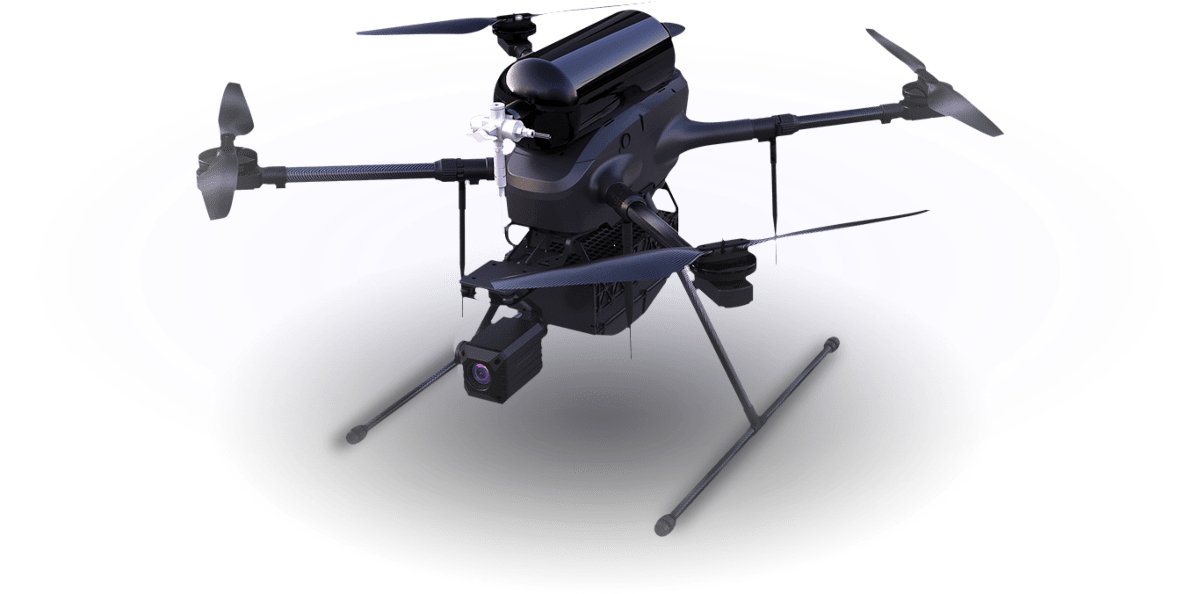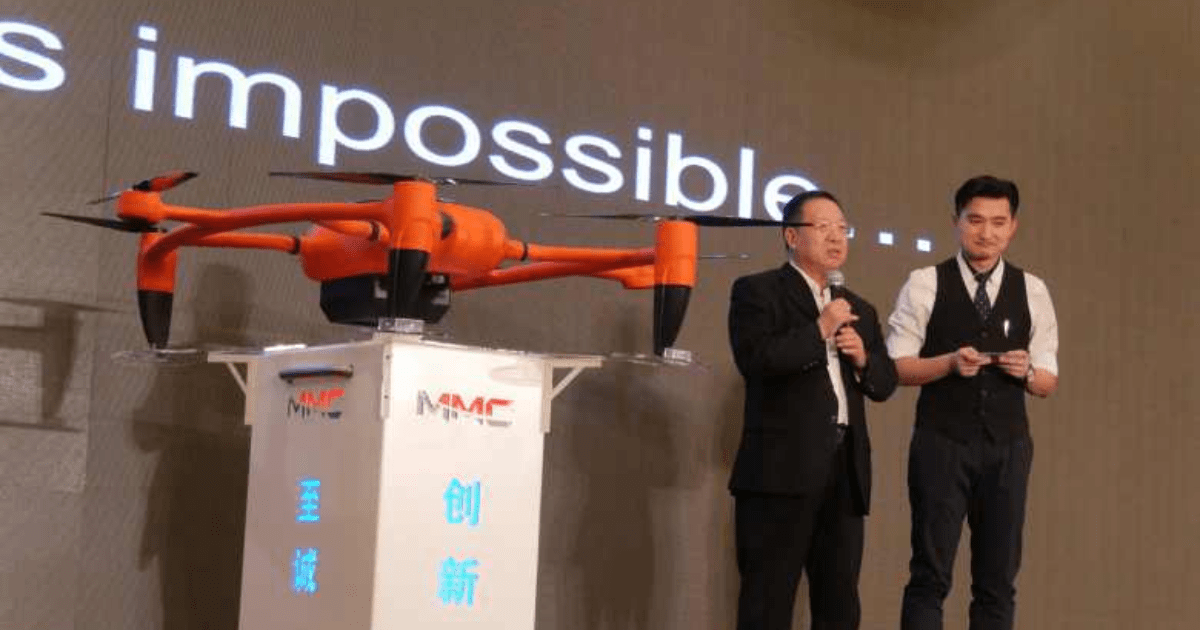Will Hydrogen Fuel the Drones of the Future? | 7 Benefits of Hydrogen Over LiPo Drones
BY Isabella Lee
20 September 2018This week, a new, hydrogen-fueled drone arrived on the commercial drone market, Narwhal 2—an upgraded hydrogen quadcopter with LTE module and 30 km video transmission range.
Narwhal 2 was designed by BSHARK in partnership with MicroMultiCopter (MMC)—manufacturer of the world’s first hydrogen-powered drone, HyDrone 1550.

Narwhal 2 is a hydrogen-powered quadcopter equipped with air cooled fuel cell technology.
What is a Hydrogen Fuel Cell?
A hydrogen fuel cell converts chemical energy stored by hydrogen fuel into electricity. Hydrogen on its own is not a source of energy. It must be kept in a suitable container until it is ready to be used in a fuel cell to produce electricity. When hydrogen is combined with oxygen within the fuel cell, and the byproduct water is removed, the fuel cell can generate electricity.
Similar to a battery, a fuel cell can be used to power devices that use electricity, like drones. However, there are some significant differences between batteries and fuel cells, which we’ll discuss below.
LiPo Batteries Power Most RC Aircraft and Drones
The majority of commercial drones on today’s market are powered by lithium polymer (LiPo) batteries. LiPo batteries have a very high energy density compared to other types of batteries, such as nickel cadmium (NiCad) or nickel–metal hydride (NiMH) batteries. A higher density means that a LiPo battery can hold more energy compared to another battery of the same weight, allowing you to power your drone longer with a battery that weighs less. They’re also rechargable, to power multiple flights.
LiPo batteries have been the dominant power source for remote control aircraft and drones for many years, going back to the 1980s. The first hydrogen-fueled drone didn’t enter the market until very recently when MMC launched its first, groundbreaking hydrogen-fueled drone on April 10, 2016.

At the launch of MMC’s first hydrogen fueled drone on April 10, 2016 in Shenzhen, China.
Hydrogen is the most abundant chemical substance on Earth. If there’s so much hydrogen floating around, why did it take so long for a hydrogen-fueled drone to enter the market? Well, there’s a catch—hydrogen is very difficult to harness—it must be separated from other elements, pressurized, and stored in stable environment, or otherwise explode. Another caveat with hydrogen fuel cells is that they involve a significant amount of heat. Considering that plastic is a dominant component of most drones, the generation of heat could melt some of the drone hardware.
Despite these drawbacks, MCC and BSHARK have still found ways to build hydrogen-fueled drones that consumers want to fly. In the eyes of these manufacturers, the benefits far outweigh the cons when it comes to hydrogen fuel cell power systems.
The 7 Benefits of Fueling Drones with Hydrogen
1. Hydrogen is a clean energy source.
Hydrogen is a colorless, odorless, and nontoxic gas that won’t produce acid rain, deplete the ozone, or produce harmful emissions. When converted to energy it only has one byproduct: water. This makes hydrogen an incredibly clean fuel source. Plus, hydrogen can produce electricity and electricity can produce hydrogen, creating an energy loop that is renewable and harmless to the environment.
2. Hydrogen is the most abundant resource on Earth.
Hydrogen is the most abundant resource on Earth and throughout the entire Universe. Think you might fly a drone on Mars one day? Even on Mars, hydrogen is still the most abundant resource.
3. Hydrogen fuel cells have a higher energy density over batteries.
Fuel cells use air for half of their reaction when converted to energy, producing a higher energy density over other batteries. This means a hydrogen tank attached to a drone will generate more energy than a LiPo battery of the same weight.
4. Hydrogen fuel cells enable longer flight times.
Due in part to benefit #3, hydrogen-fueled drones fly longer than LiPo powered drones. In addition to the high energy density of hydrogen, its unique method of creating and releasing energy impacts flight time as well. Regular batteries store energy and release it on demand, while hydrogen fuel cells produce energy only as required. This unique behavior has enabled hydrogen-fueled drones to fly for up to two and a half hours in the case of MCC’s HyDrone 1550 and up to two hours with BSHARK’s new Narwhal 2. Most LiPo powered drones have a maximum flight time of 25-30 minutes, but there are a few ways you can extend the life of your sUAS LiPo battery.
5. Hydrogen fuel cells refuel quickly.
In the past, Hydrogen fuel has not been readily accessible by the public, and it’s still difficult to find. However, BSHARK has just made Orca1, a mobile hydrogen fueling station with 99.999% output purity of hydrogen, available for hydrogen fueling at home. When compared to the time it takes to recharge a LiPo battery, a hydrogen fuel cell can be refueled much faster within just a few minutes.
6. Hydrogen-fueled drones function in low temperatures.
Hydrogen fuel cells require the constant presence of oxygen but are not affected by low temperatures. This expands the use of drones into northern and southern latitudes. The ability to function in low temperatures will open up new applications for drones.
7. BVLOS flights are more attainable with hydrogen-fueled drones.
Since hydrogen-fueled drones have longer flight times and can operate in lower temperatures, they’re more reliable for beyond-visual-line-of-sight (BVLOS) flights. However, changes in regulation around BVLOS flights will need to occur first before we reap the full benefits of hydrogen-fueled drones.
BSHARK’s Narwhal 2
One of the latest drones to take advantage of the benefits of hydrogen is the Narwhal 2. Based on aerial aluminum, the frame of Narwhal 2 is rain, dust, and fireproof. As a drone fueled by hydrogen, Narwhal 2’s core components must be absolutely reliable. Take a look at some other standout features of Narwhal 2:
- 120 min flight time
- Foldable design
- 5 flight modes
- 2.4/5.8GHz dual fallback channel, wireless video transmission
- 30 KM video transmission control range
- Compact all-in-one remote control station
Who Else is Using Hydrogen?
Hydrogen is already being used by other transportation manufacturers. NASA uses hydrogen to power spaceships. Big-box car companies like Toyota and Mercedes already have hydrogen fuel cell electric vehicles on the market. UPS began testing its own hydrogen delivery trucks in 2017 and added over 700 alternative-fuel trucks to its fleet in 2018.
Will hydrogen become the next dominant energy source? It’s possible, but until hydrogen becomes easier to harness, and more accessible to the public, drones will continue to be powered predominantly by LiPo batteries. Perhaps BSHARK’s latest launch of the Narwhal 2 will propel hydrogen-fueled drones onto the commercial drone market.
You can share your thoughts on the pros and cons of hydrogen-fueled drones in this thread on our community forum.


